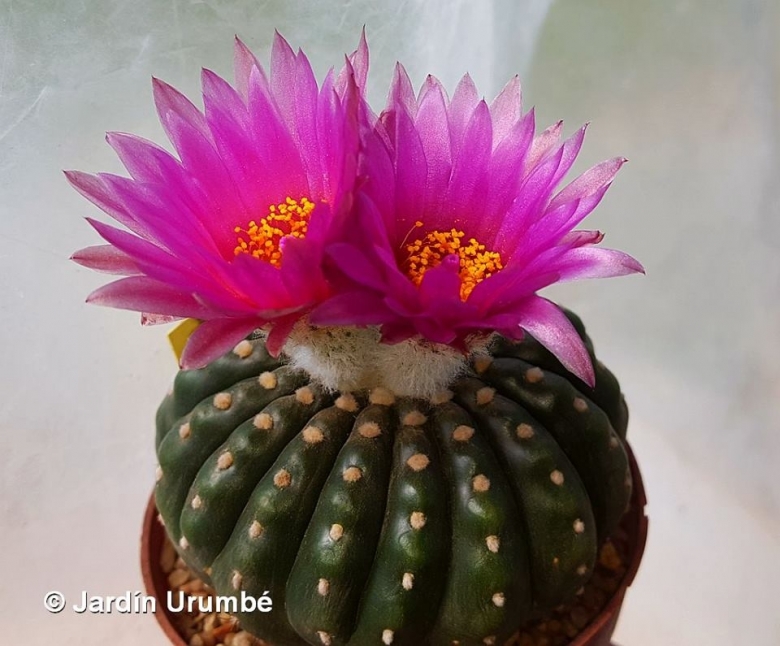Accepted Scientific Name: Parodia werneri Hofacker
Cactaceae Consensus Init. 6: 12, nom. nov. 1998 [replaced synonym: Notocactus uebelmannianus Buining]

Parodia werneri f. inermis Photo by: Alexander Arzberger
Origin and Habitat: Garden origin (Nursery produced). The wild species occurs over a considerable range in the area of Rio Grande Do Sul, Brazil.
Synonyms:
See all synonyms of Parodia werneri
back
Accepted name in llifle Database:Parodia werneri HofackerCactaceae Consensus Init. 6: 12, nom. nov. 1998 [replaced synonym: Notocactus uebelmannianus Buining]Synonymy: 24
back
Description: Parodia werneri f. inermisSN|19997]]SN|33226]] is the nice spineless form of Parodia werneriSN|19997]]SN|19997]] (syn: Notocactus uebelmannianusSN|19998]]SN|19998]]). The spines are present but extremely reduced only about 1 mm long and completely disappear in the wool of areoles, all the other characteristics namely size and shape of stems, flowers, fruits, roots etc. clearly show that they are conspecific.
For more details see: Parodia werneriSN|33226]]SN|19997]]
Subspecies, varieties, forms and cultivars of plants belonging to the Parodia werneri group
 Parodia werneri f. inermis Photo by: Alexander Arzberger
Parodia werneri f. inermis Photo by: Alexander ArzbergerSend a photo of this plant.The gallery now contains thousands of pictures, however it is possible to do even more. We are, of course, seeking photos of species not yet shown in the gallery but not only that, we are also looking for better pictures than those already present.
Read More... Cultivation and Propagation: Parodia werneriSN|19997]]SN|19997]] (syn: Notocactus uebelmannianusSN|19998]]SN|19998]]) is easy to grow and quite resistant to neglect. Nevertheless, it is appropriate to provide adequate growing conditions in order to obtain abundant blooms.
Growth rate: It is a relatively rapidly growing species that will make large clumps given the best conditions.
Soils: It needs a standard cactus mix soil with an excellent drainage. Prefer a low pH compost, avoid substrata too rich in limestone.
Repotting: This plant needs plenty of space for its roots, repotting should be done every other year or when the it has outgrown its pot. It is rot prone and should be planted in a shallow pot. Use pot with good drainage.
Watering: Needs regular water in spring to autumn in summer (it is more demanding than other cactus), but do not overwater, keep dry in winter or give them a very small amount about once a month in winter to prevent shrinkage and root loss.
Fertilization: Feed with a high potassium fertilizer in summer. Regular water in spring to autumn. I tend to
Hardiness: It is moderately frost resistant if kept dry and hardy to -4° C for short periods (depending on varieties and growing conditions). However warmth throughout the year will increase the grower's success (at temperatures from 5 to 15 degrees centigrade during rest season).
Exposition: The plant tolerates bright situations which encourages flowering and heavy spine production, but is likely to suffer from sun scorch or stunted growth if over exposed to direct sunlight during the hottest part of the day in summer. It grows well with filtered sunlight or afternoon shade.
Uses: It is an excellent plant for container growing. It look fine in a cold greenhouse and frame or outdoor in a rockery. It is also used as a rootstock for grafting delicate and slow growing cactus species.
Pests & diseases: It may be attractive to a variety of insects, but plants in good condition should be nearly pest-free, particularly if they are grown in a mineral potting-mix, with good exposure and ventilation. Nonetheless, there are several pests to watch for:
- Red spiders: Red spiders may be effectively rubbed up by watering the plants from above.
- Mealy bugs: Mealy bugs occasionally develop aerial into the new growth among the wool with disfiguring results, but the worst types develop underground on the roots and are invisible except by their effects.
- Scales: Scales are rarely a problem.
- Rot: This species is particularly easy and accommodating, seldom suffer of cryptogamic diseases. Rot it is only a minor problem with cacti if the plants are watered and “aired” correctly.
Propagation: Direct sow after last frost, offsets (if available) . Seeds germinate in 7-14 days at 21-27° C in spring, remove gradually the glass cover as soon the plants will be well rooted (ca 1-2 weeks) and keep ventilated, no full sun for young plants! To make a cutting twist off a branch and permit it to dry out a couple of weeks, lay it on the soil and insert the stem end partially into the soil. Try to keep the cutting somewhat upright so that the roots are able to grow downward.












